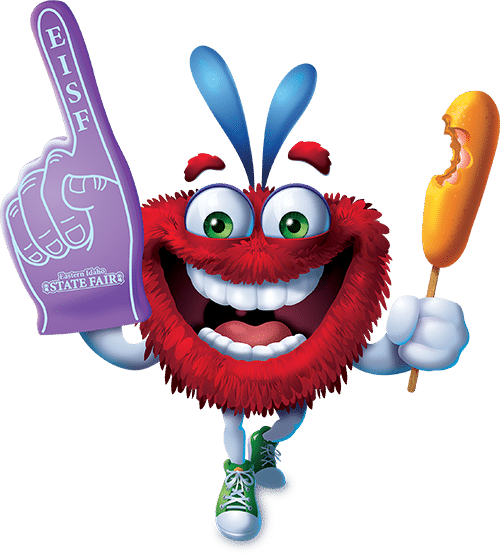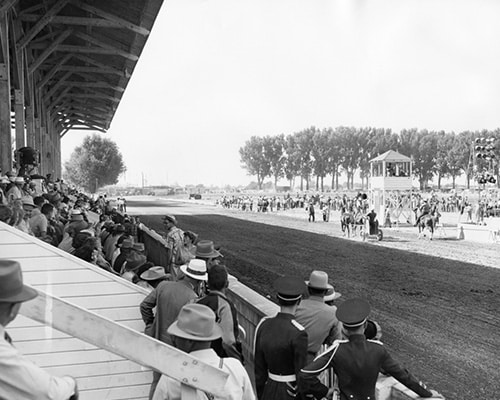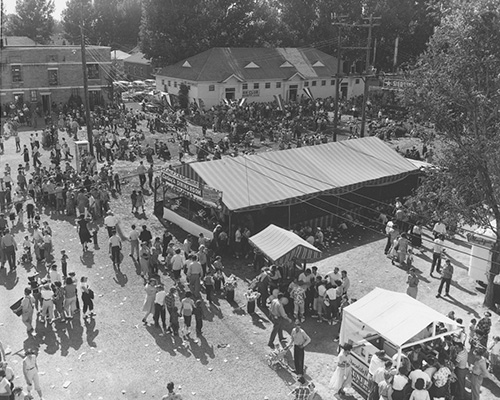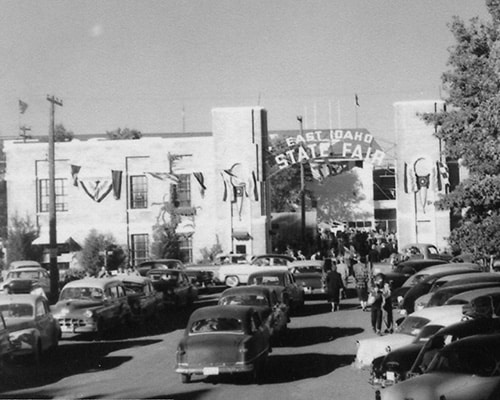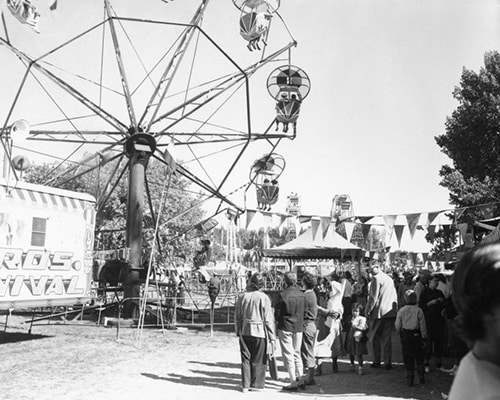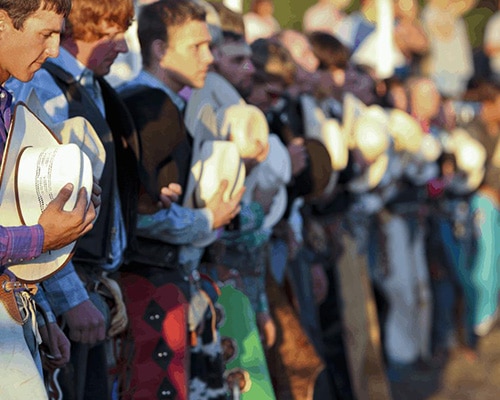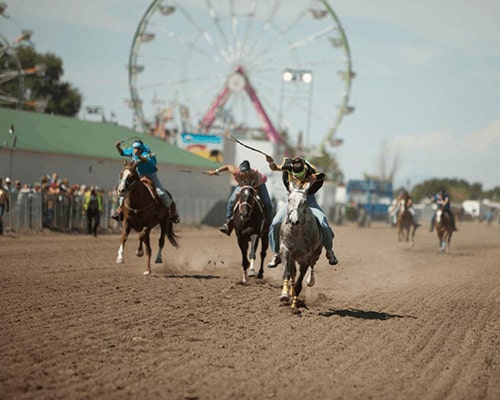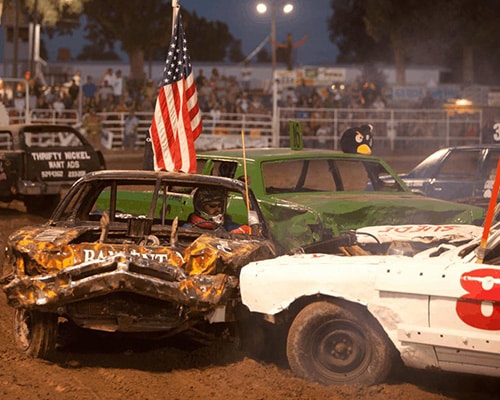OVER 250,000 VISITORS
From its early origins as a livestock show in 1902, the Eastern Idaho State Fair has become a favorite annual destination for families, young and old, creating fond memories and unforgettable experiences.
For more than a Century, the Fair has upheld its mission to provide wholesome, affordable, family-oriented entertainment and education in an agricultural environment within clean and safe surroundings.
Agriculture has always been the backbone of the Eastern Idaho State Fair. Over nine days, the Fair is home to over 2,000 animals, including beef cattle, draft horses, sheep, pigs, goats, rabbits, poultry, and pigeons. The Fair receives over 6,000 entries from Idahoans, young and old, entering their hobbies and livestock in 26 competition categories. This includes Livestock, Flowers, Baking, Canning, Needlecraft, Antiques, Fine Arts, Hobbies & Craft, Photography, Native American, FFA, and 4-H.
Nearly 70 food vendors feed hungry visitors with favorites such as corn dogs, giant turkey legs, funnel cakes, and tiger ears. More than 200 vendors showcase their services throughout the grounds. For the last several years, attendance has exceeded 250,000 visitors. Not bad for a community of 15,000 people.
IN THE BEGINNING
The Fair originated in 1902 when a group of cattlemen decided to organize a livestock show in Blackfoot. They collectively purchased a piece of land to hold the event, which was a success. The Pocatello Tribune covered the show, reporting on October 9, 1902: "This is a great day in the history of Blackfoot. There were cattle on display as well as floral and agricultural exhibits."
For the next 16 years, the Southeastern Idaho Fair operated continuously. In 1906, it introduced the first merry-go-round powered by a steam engine. Additionally, in 1912, the Fair Board of Directors spent $900 to bring Teddy Roosevelt to the fairgrounds by train for a campaign speech. However, in 1918, financial difficulties forced the fair to shut down for several years.
Fortunately, county leaders and the Farm Bureau saw the value of the fair and purchased the land, reopening the Fair in 1920. Five years later, the Fair became a four-day event. Also that year, the Idaho Legislature passed Multi County Fair District laws. Three counties in southeast Idaho – Bingham, Bonneville, and Bannock – created the Eastern Idaho Fair District. In 1930, a fourth county – Clark – became part of the Fair District. With 16 counties today, the Eastern Idaho State Fair is the only multi-county district fair in the State of Idaho
EISF IS BORN
In the late 1930s, the Eastern Idaho Fair District faced a significant challenge when the Utah State Fair changed its dates to coincide with the Blackfoot event. The Fair Board decided not to alter its schedule and instead challenged the Utah Fair by renaming itself the Eastern Idaho State Fair. At that time, 12 counties were part of the Fair District, which attracted nearly 40,000 visitors each year.
During this period, a significant construction project was undertaken, and with the help of horses and a pulley system, the Grandstands were built. Concurrently, the Arts & Crafts department was established, adding more variety to the home arts events held during the Fair. New contests were introduced, including a Potato Picking Contest in 1939, where the Governors of Idaho and Maine competed. (Sadly, the Governor of Maine emerged victorious.)
In 1940, the Fair constructed its iconic arch sign and administrative offices with the assistance of the Corps of Engineers. A plaque was placed on each office to commemorate this significant project. That year, attendance reached over 66,000, along with an additional 25,000 student admissions over six nights and five days, breaking all previous records.
However, two years later, the United States entered World War II, prompting the Fair to suspend operations to support the American war effort. Fair officials rented out their buildings to assist the county by storing surplus food supplies and equipment. Tragically, that same year, a fire destroyed the commercial building which housed a potato dehydration plant. The fire consumed 250,000 pounds of potatoes, 50 tons of coal, and all the equipment inside. It took over ten years to rebuild the structure.
The Eastern Idaho State Fair resumed operations in 1944, and less than one week after the completion of the 1944 Fair on September 22, 1944, the U.S. Army set up headquarters at the fairgrounds to guard and manage 500 Italian prisoners of war for over a month. In what was called the "acute harvest labor crisis in the country," the Italian POW's dug sugar beets and potatoes during their stay in Southeast Idaho. This event brought the reality of war and its effects directly to the people of this area.
NO BETTING ON HORSE RACING
After World War II ended in 1945, the Fair encountered new challenges. First-day attendance reached 15,000 fairgoers, a 50% increase from previous years, as new attractions—including grandstand shows, aerial acrobats, a Disappearing Water Ballet, and Pete Siebrand's Carnival—drew large crowds. By 1948, attendance surged to over 82,000 over the five-day event, leading to significant housing shortages in Blackfoot for Fair attendees.
During this period, several improvements were made, including the development of a new Midway area on the west side, a new steel exhibit building, four new livestock barns, and 50 new stalls for racehorses. From 1946 to 1948, the Fair first introduced betting on horse racing; however, after two years, the Board decided to discontinue this practice. For years, the Board lobbied for horse racing legislation, facing repeated vetoes from the Governor of Idaho. Eventually, they succeeded in passing the legislation.
The latter half of the 20th Century was marked by continued innovation and growth at the Eastern Idaho State Fair. In 1964, legislation enabling horse racing was finally passed, leading to the start of pari-mutuel racing. However, that same year, the new pari-mutuel racing commission and the Fair Board made the controversial decision to cancel the Indian Relay races. This event, run by the Shoshone-Bannock Tribal Council, had been a popular and integral part of the Fair since its early years. The decision faced immediate backlash from individuals who described the Indian Relay races as "the most popular part of the racing program." After refining its schedule, the racing commission reinstated the Indian Relay National Championship races in 1965. Since then, these races have consistently taken place alongside the horse races, continuing to attract large crowds to the grandstand on race days.
LIVE IN 3 ... 2 ...
In 1968, KIFI-TV chose the Eastern Idaho State Fair as the site for its first LIVE broadcast, featuring weatherman Lloyd Lindsey Young.
The 1970s and 1980s brought significant improvements to the fairgrounds, including the construction of a new 4-H building, the $500,000 Goddard Livestock Pavilion, and a dedicated Hobbies & Crafts building. In 1972, the Fair began adopting annual themes, with the inaugural theme being "Six Big Days and Nights: Spectacular Fun for Everyone!" The Demolition Derby was introduced in 1974 and quickly became a beloved Fair tradition, benefiting the Blackfoot Elks Club, which uses the proceeds to support youth programs throughout Southeastern Idaho. This event has since become the Grand Finale of the Fair.
Attendance at the Fair continued to grow; by the mid-1980s, around 50,000 people were attending on opening day, with total attendance nearly reaching 220,000. By 1989, the Fair had expanded to an eight-day event.
In the 1990s, the Fair brought in Butler Amusements to begin providing the Carnival; with over 30 rides and numerous game booths, they have maintained a solid relationship since with the Eastern Idaho State Fair. The Fair established a permanent stage for its nighttime entertainment, which during this time featured music legends Charlie Daniels and Travis Tritt.
BIGGER IS BETTER
As we move further into the 21st Century, the Eastern Idaho State Fair remains Southeastern Idaho's longest-running annual event. In 2010, the Fair enhanced its online Grandstand Event Ticket ordering process, making it more convenient for attendees to purchase tickets in advance. This improvement helped visitors avoid long lines for ticket purchases or will-call pick-up.
That same year, the Fair Board reinforced the Fair's smoking policy, establishing that most areas of the Fair are now smoke-free, with only two designated smoking areas. This change promotes a healthier environment for visitors, workers, and the animals that participate in this beloved annual tradition.
In 2017, the Fair adopted the theme "Bigger is Better," reflecting an expansion of the event. The Fair was extended to a 9-day schedule, starting on the Friday before Labor Day and continuing through the Saturday after Labor Day each year.
The Fair set an all-time attendance record in 2018, welcoming nearly 249,000 visitors, and maintained similar attendance levels in 2019. Additionally, the Fair has embraced technology to enhance communication with its audience through its website and social media platforms, including Facebook, Instagram, Snapchat, and Twitter.
In 2020, the Eastern Idaho State Fair faced a significant challenge, as it was unable to hold the event for the first time in 75 years due to the world-wide outbreak of the COVID-19 virus. Like many parts of the world, life in Southeastern Idaho looked very different due to the circumstances. However, we were determined to stay connected to our roots in youth, animals, and country life, so we organized a "2020 Modified Eastern Idaho State Fair."
This modified fair featured 4-H competitions on the grounds, which saw the largest participation of youth and animals in over a decade. Additionally, we hosted two nights of the "Gem State Classic Pro Rodeo," albeit with limited attendance. Earlier in 2020, our rodeo had been voted the "2019 Small Rodeo of the Year," and it went on to be nominated again, finishing in the Top 5 in the nation.
For our dedicated fair food enthusiasts, we also held a "Fair Food Frenzy" during the "2020 Modified Eastern Idaho State Fair," which featured 15 of our favorite food vendors to provide a much-needed taste of normalcy.
LOOKING AHEAD
The success of the Eastern Idaho State Fair can be attributed to the residents of Eastern Idaho, who return to the Fair year after year. The dedicated Board of Directors, County Commissioners from all 16 counties, Fair Management, and Fair Staff have invested countless hours over the years to organize this annual event in Blackfoot. Additionally, sponsors and local organizations have provided generous support. Although there have been challenges along the way, supporters recognize the Fair's significance and value to the people of Idaho, ensuring its continued presence.
The Eastern Idaho State Fair looks forward to even more success in the next 100 years!
